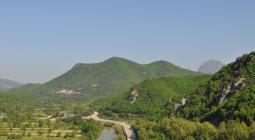Don’t blame the trees! Saving forests is still the best way to save the planet
The smokescreen generated by recent carbon-offset setbacks should not blind us to the simple truth that we must protect our intact forests and bring back those we have lost
Some have recently questioned whether forests really are the climate solution they have long been held to be. This is because some emit great quantities of carbon, while the markets set up to finance them have stumbled. But there is no pathway to a livable climate without saving our intact forests, regrowing some, and finding a more straightforward way to pay for them than carbon offset projects.
A 2021 study led by Brazilian scientists established that the Amazon was emitting more carbon dioxide than it was absorbing. The great carbon sink had seemingly become a smokestack. The paper mirrored a 2019 analysis of Canadian forests, which showed they had been net emitters since 2001.
This year, as blazing forests choked the skies across eastern North America, a New York Times columnist went so far as to muse that the trees might be doing it on purpose, “fighting for the other side”.
Forests absorb and emit carbon every day. During photosynthesis, they soak it up from the air and use it to make leaves, branches, fruit and other plant parts. The solid carbon is released back into the atmosphere when it burns or decomposes. Carbon is always coming and going; the important number to watch is the net change.
Forests damaged by logging, roads or by the climate crisis itself have become more prone to fire and may grow slower than in the past. They’re absorbing CO2, just not quite as much as they’re releasing. Globally, however, forests continue adding vastly more carbon than they are losing. To the degree that forests may take sides, they are still on ours.
The other challenge to forests’ reputation is the carbon-offset markets set up to finance tree protection and planting. Most transactions are between companies that voluntarily offset their greenhouse gas emissions by paying to save or regrow forests. Recent reports have shown they commonly fail to produce promised climate benefits and can sow divisions in communities.
The most cost-effective and environmentally beneficial thing we can do is preserve the intact forests
A New York Times column on treacherous trees conflated markets’ failures with the alleged failure of the forest to store carbon. That’s wrong, but understandable. In a November press release, Verra, the leading firm that certifies carbon deals, said: “Carbon markets are the best and most readily available tool we have for forest protection.”
If that were true, we would have few forests left. In fact, the greatest episode of deforestation reduction in history came in the early 2000s in Brazil. It was powered by 24m hectares (59.3m acres) of new protected areas (most designed to enable sustainable forest economies rather than kicking people out), vast Indigenous lands declared in the decade prior, a law enforcement blitz and targeted incentives such as credit restrictions. Voluntary carbon projects paid for none of this.
Forests are life-giving allies in the climate fight, and we know how to support them. By far the most cost-effective and environmentally beneficial thing we can do is preserve the intact forests that still blanket large areas, especially in the tropics and the boreal zone.
The tropics have the largest stores of above-ground carbon, while the boreal forests of Canada, Alaska and Russia have the biggest carbon stocks in deep forest soils.
As a second priority, we need to bring forests back. About half of the globe’s woods have been cleared, with 80% of the remainder affected by development. A study published last month in Nature said that regrowing forests could absorb 226bn tonnes of carbon from the atmosphere. That’s about 23 years’ worth of worldwide carbon emissions at 2022 levels.
It’s surely an overestimate, unconstrained by budget or the realities of convincing landowners to grow trees. And we’re finding that, in practice, the climate crisis is already stopping Amazon forests from growing back to their previous luxuriance. The point remains, however, that there’s ample space and an urgent need not only to end deforestation but also to reforest.
To pay for it, our best bet is a mix of traditional public funding and large-scale carbon finance agreements such as the Amazon Fund, launched by Brazil and Norway in 2008. Additional deals are now in the works for entire countries and states to reduce deforestation, the so-called jurisdictional approach, which achieves scale and could solve many of the accounting and equity problems of the voluntary carbon projects.
Brazil is now poised to approve a domestic carbon cap-and-trade system, but unfortunately this will exclude deforestation. On 1 December, it unveiled a global Tropical Forests Forever fund that would pay/penalise countries based on the area they preserve/deforest, not the amount of carbon held therein.
This simplicity is welcome, as is the recognition that forests are webs of wild biology linked to human cultures, doing much more than balancing the great carbon equation.
John W Reid co-authored Ever Green: Saving Big Forests to Save the Planet, and is the founder and former president of the Conservation Strategy Fund. Paulo Moutinho is a co-founder and senior researcher at the Institute for Environmental Research in the Amazon
Cover photo: Sunrise on the Amônia River in western Brazil. The mist that rises from rainforests form invisible watercourses in the atmosphere. When this moisture meets the Andes, they contribute directly to the streams that flow into the Amazon. Photograph: Nicoló Lanfranchi/The Guardian





